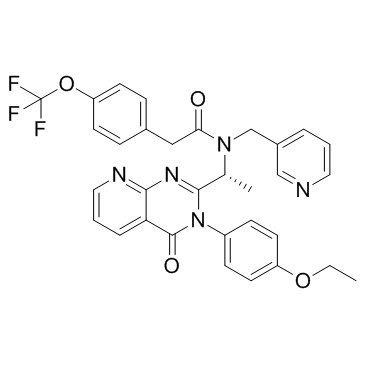473719-41-4
| Name | amg 487 |
|---|---|
| Synonyms |
Benzeneacetamide, N-((1R)-1-(3-(4-ethoxyphenyl)-3,4-dihydro-4-oxopyrido[2,3-d]pyrimidin-2-yl)ethyl)-N-(3-pyridinylmethyl)-4-(trifluoromethoxy)-
N-[(1R)-1-[3-(4-ethoxyphenyl)-4-oxopyrido[2,3-d]pyrimidin-2-yl]ethyl]-N-(pyridin-3-ylmethyl)-2-[4-(trifluoromethoxy)phenyl]acetamide |
| Description | AMG 487 is an antagonist of chemokine receptor 3 CXCR3 which inhibits the binding of CXCL10 and CXCL11 to CXCR3 with IC50s of 8.0 and 8.2 nM, respectively. |
|---|---|
| Related Catalog | |
| Target |
125I-IP10-CXCR3:8 nM (IC50) 125I-ITAC-CXCR3:8.2 nM (IC50) |
| In Vitro | AMG 487 inhibits CXCR3-mediated cell migration by the three CXCR3 chemokines (IP-10 IC50=8 nM, ITAC IC50=15 nM, and MIG IC50=36 nM). Furthermore, AMG 487 inhibits calcium mobilization in response to ITAC (IC50=5 nM)[1]. AMG487 (1 μM) develops into fewer lung metastases, and the lungs are significantly smaller than vehicle-treated lungs[2]. AMG487 abrogates proliferation/survival of C26 tumour cells[3]. |
| In Vivo | AMG 487 (0.03-10 mg/kg, s.c.) exhibits significant reduction in cellular infiltration into the lungs in a dose dependent manner[1]. AMG487 (5 mg/kg, s.c., twice daily) develops fewer metastases than that in vehicle-treated mice[2]. AMG487 (5 mg/kg, s.c.)-treated mice exhibits fewer pulmonary nodules than the control mice in both the models. AMG487 reduces the tumour volume[3]. |
| Kinase Assay | Cells are then lysed and sonicated in 50 mM Hepes pH 7.5, 150 mM NaCl, 20 mM EDTA, 1 mM PMSF, 10 μg/mL leupeptin, 2 μg/mL aprotinin and 0.2% NP-40. Equal amount of lysates are mixed in substrate buffer (50 mM Hepes, 100 mM NaCl, 1 mM EDTA, 10% sucrose, 0.5% CHAPS, 5 mM dithiothreitol) with Ac-DEVD-AMC substrate and caspase-3/7 substrate in a microtiter plate. Production of fluorigenic substrate is measured continuously at 37°C in a spectrophotometer Ascent Fluoroskan and the caspase activity (expressed as U/mg of protein) is defined as the amount of enzyme cleaving 1 nmol of substrate/min. |
| Cell Assay | Colon cancer cells are seeded at a density of 104 cells cm2 and incubated either in serum-enriched medium or in base medium (containing 0.1% bovine serum albumin, BSA) supplemented or not with various concentrations of rCXCL9, rCXCL10 and rCXCL11 for the indicated periods of time before being either trypsin-detached, collected and enumerated or re-fed with fresh medium for 3 days, harvested and enumerated. The morphology of the CRC cells is observed through an inverted optical microscope at ×20 magnification, and photographs are taken at day 7. |
| Animal Admin | Local tumor growth and spontaneous metastasis are evaluated by injecting 3×105 viable tumor cells s.c. proximal to the right abdominal mammary gland of syngeneic female mice. Tumor diameters are measured by caliper twice weekly, and mice are euthanized on an individual basis when the s.c. tumor measured 18 mm in diameter or earlier if the mouse seemed moribund. The lungs are removed and weighed, and surface tumor colonies are quantified in a blinded fashion under a dissecting microscope. Experimental metastasis is evaluated by injecting 9×104 viable tumor cells i.v. into the lateral tail vein of syngeneic female mice. All mice are euthanized on day 21 posttransplantation or earlier if the mice seemed moribund. The lungs are removed and weighed, and surface tumor colonies are quantified in a blinded fashion under a dissecting microscope. A 50% hydroxypropyl-β-cyclodextrin solution is prepared; at 20%, this solution serves as the vehicle. AMG487 is added to the 50% solution, and it is incubated in a sonicating water bath for 2 hours with occasional vortexing. Distilled water is added to give the appropriate final concentration of AMG487 in 20% of hydroxypropyl-β-cyclodextrin. |
| References |
| Molecular Formula | C32H28F3N5O4 |
|---|---|
| Molecular Weight | 603.59100 |
| Exact Mass | 603.20900 |
| PSA | 99.44000 |
| LogP | 5.80550 |
| Storage condition | 2-8℃ |
